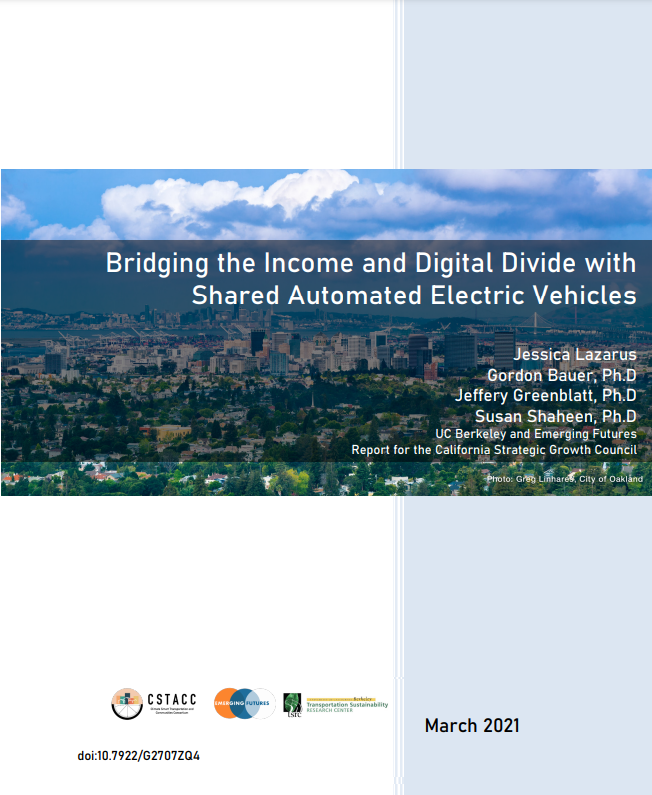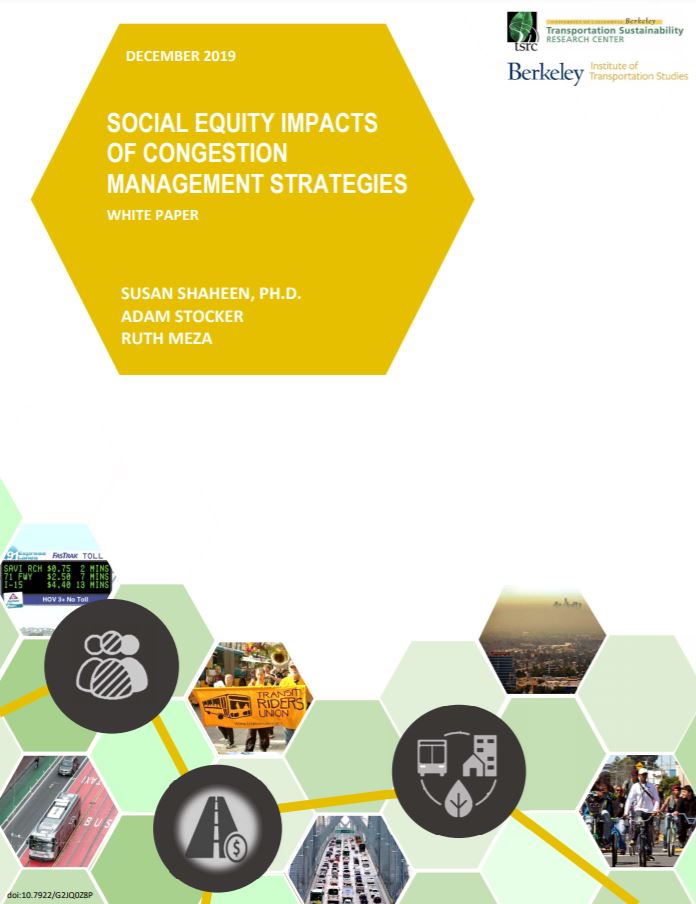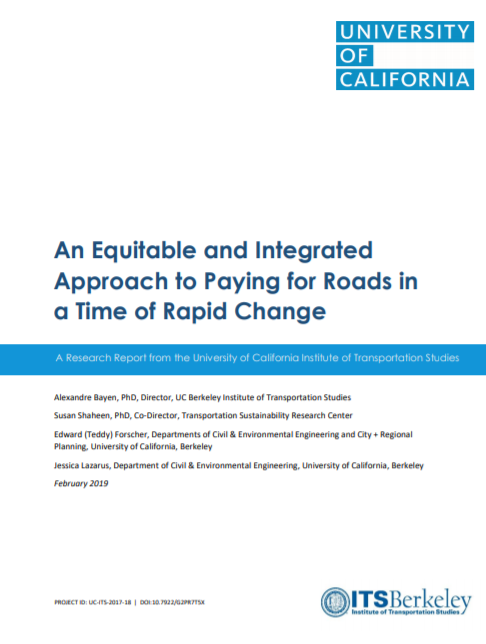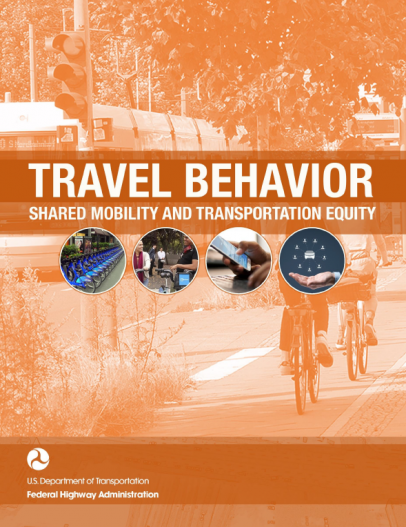Read “Bridging the Income and Digital Divide with Shared Automated Electric Vehicles” by Jessica Lazarus, Gordon Bauer, Jeffery Greenblatt, and Susan Shaheen
This research investigates strategies to improve the mobility of low-income travelers by incentivizing the use of electric SAVs (SAEVs) and public transit. We employ two agent-based simulation engines, an activity-based travel demand model of the San Francisco Bay Area, and vehicle movement data from the San Francisco Bay Area and the Los Angeles Basin to model emergent travel behavior of commute trips in response to subsidies for TNCs and public transit. Sensitivity analysis was conducted to assess the impacts of different subsidy scenarios on mode choices, TNC pooling and match rates, vehicle occupancies, vehicle miles traveled (VMT), and TNC revenues. The scenarios varied in the determination of which travel modes and income levels were eligible to receive a subsidy of $1.25, $2.50, or $5.00 per ride. Four different mode-specific subsidies were investigated, including subsidies for 1) all TNC rides, 2) pooled TNC rides only, 3) all public transit rides, and 4) TNC rides to/from public transit only. Each of the four mode specific subsidies were applied in scenarios which subsidized travelers of all income levels, as well as scenarios that only subsidized low-income travelers (earning less than $50,000 annual household income). Simulations estimating wait times for TNC trips in both the San Francisco Bay Area and Los Angeles regions also revealed that wait times are distributed approximately equally across low- and high-income trip requests.
Read “Strategies to Overcome Transportation Barriers for Rent Burdened Oakland Residents” by Alexandra Pan and Susan Shaheen
Shared mobility is gaining traction in the transportation community as a potentially more environmentally friendly alternative to automobile travel and complement to public transit. However, adoption and use of shared mobility by low-income individuals lags behind other demographic groups. Additional research is needed to better understand the transportation needs of low-income travelers and how public agencies, community-based organizations, and shared mobility operators can work together to best serve those needs.
This research fills gaps in understanding the potential policy strategies that could be effective at increasing the access, awareness, and use of shared mobility by low-income individuals. We employ Oakland, California as our primary study site (see Figure 1 and Table 1 for more detail). In this report, we present our findings on barriers to shared mobility from a review of existing shared mobility social equity initiatives, expert interviews (n=13) and focus groups with rent burdened residents of East Oakland (n=24). We further investigate barriers and implications for transportation use in an online survey (n=177), as well as longitudinal panel of phone and video interviews (n=31) with rent burdened Oakland residents. Rent burden refers to the percentage of income spent on rent and can more widely capture the population of Oakland residents who are struggling to keep up with rising housing costs.
Read “Social Equity Impacts of Congestion Management Strategies” by Susan Shaheen, PhD, Adam Stocker, and Ruth Meza.
This white paper examines the social equity impacts of various congestion management strategies. The paper includes a comprehensive list of 30 congestion management strategies and a discussion of equity implications related to each strategy. The authors analyze existing literature and incorporate findings from 12 expert interviews from academic, non-governmental organization (NGO), public, and private sector respondents to strengthen results and fill gaps in understanding. The literature review applies the Spatial – Temporal – Economic – Physiological – Social (STEPS) Equity Framework (Shaheen et al., 2017) to identify impacts and classify whether social equity barriers are reduced, exacerbated, or both by a particular congestion mitigation measure. The congestion management strategies discussed are grouped into six main categories, including: 1) pricing, 2) parking and curb policies, 3) operational strategies, 4) infrastructure changes, 5) transportation services and strategies, and 6) conventional taxation. The findings show that the social equity impacts of certain congestion management strategies are not well understood, at present, and further empirical research is needed. Congestion mitigation measures have the potential to affect travel costs, commute times, housing, and accessibility in ways that are distinctly positive or negative for different populations. For these reasons, social equity implications of congestion management strategies should be understood and mitigated for in planning and implementation of these strategies.
Read “An Equitable and Integrated Approach to Paying for Roads in a Time of Rapid Change” by Alexandre Bayen, Susan Shaheen, Edward (Teddy) Forscher, and Jessica Lazarus.
A brief overview of transportation user fees (historically and in a contemporary context) is presented followed by a discussion on how segmenting travel into three categories –long haul, the last mile, and at the curb–creates a new typology for transportation pricing and access mechanisms. A case study based upon California’s recent Road Charge Pilot Program demonstrates a quantitative example for a blended long haul/last mile approach using a parametric mileage-based user fee (MBUF); the case investigates distributional cost burdens under different pricing calibration scenarios. There are many ways to raise the same amount of money with a parametric structure, but compared to a gas tax and flat mileage-based fee, a parametric structure may produce a better distribution of cost burdens. Technical, political, legal, and other considerations for implementing an MBUF are discussed, drawn from a literature review of current efforts; often these aspects can direct the development of a pricing mechanism as much if not more than empirically derived goals. The conclusion discusses how this approach can aid in the development of pricing mechanisms that move closer to the user-pays principle.
Read “Travel Behavior: Shared Mobility and Transportation Equity” by Susan Shaheen, PhD, Corwin Bell, Adam Cohen, and Balaji Yelchuru.
Shared mobility—the shared use of a motor vehicle, bicycle, or other low-speed transportation mode that allows users to obtain short-term access to transportation on an as-needed basis—has the potential to help address some transportation equity challenges. In an effort to categorize the myriad of transportation equity barriers facing transportation system users, this primer proposes a ‘STEPS to Transportation Equity’ framework including: Spatial, Temporal, Economic, Physiological, and Social barriers. For each barrier category, shared mobility opportunities and challenges are explored along with policy recommendations.
Read “Exploring electric vehicle carsharing as a mobility option for older adults: A case study of a senior adult community in the San Francisco Bay Area” by Susan Shaheen, Lauren Cano, and Madonna Camel.
By the year 2030, 57 million people will be over the age of 65 in the United States. Baby boomers drive approximately 17% more than other age groups and are active well past retirement. This article examines electric vehicle (EV) carsharing (short-term vehicle access) as a future alternative to vehicle ownership for older adults living on fixed incomes in a gated community to provide reduced-cost mobility and eliminate vehicle maintenance hassles. The authors conducted a study of the response to the EV carsharing concept in a senior community in northern California, between winter 2009 and spring 2011, to gauge early adoption potential. The study consisted of in-depth interviews (n = 7), four focus groups (n = 31), and survey data collection (n = 443) with residents of the Rossmoor Senior Adult Community in Walnut Creek, California. Eighty-three percent of survey respondents drive short distances often (8 km five times/month); 100% of interview participants plan their trips in advance; and 77% of focus group subjects made changes to their driving behavior due to high fuel prices. These findings are indicators that an EV carsharing program could potentially complement travel patterns and price sensitivity. Finally, the survey results indicate that 30% of all respondents were interested in participating in an EV carsharing program, while 36% may be interested. If the carsharing fleet also contained non-EVs, 71% of community-wide survey participants were interested or may be interested in participation. Inclusion of EVs and non-EVs in the carsharing fleet would likely increase interest and participation overall.
Read “Video Transit Training for Older Travelers: A Case Study of the Rossmoor Senior Adult Community, California” by Susan Shaheen and Caroline Rodier.
In this study, the authors applied principles of social learning and marketing to develop a transit training video for residents of the Rossmoor senior adult community in California. The video features familiar community members successfully navigating specific concerns and problems related to transit use in accessing key community destinations (shopping, health care, and the nearest Bay Area Rapid Transit district station). To evaluate the effectiveness of the video, residents were recruited to complete questionnaires before and after viewing it. Video messages aimed to educate viewers on how to obtain transit information, costs, and payment generated a significant and positive attitudinal change. However, respondents reported that the video did not adequately address the difficulties associated with reading schedules and climbing stairs at transit stations. Survey results also indicate a significant and positive change in respondents’ future use of a broader range of Internet-related information sources. The results also reveal a significant and positive change among respondents in using transit services to the specific destinations presented in the video. However, results are mixed on whether participants might take transit to general destinations not explicitly presented in the video.
Read “A Checklist of Immediate Actions for Addressing COVID-19 as Part of Evacuation Planning” by Stephen Wong, Jacquelyn Broader, and Susan Shaheen.
Well planned and coordinated evacuations are critical to saving lives during natural disasters (e.g., hurricanes, wildfires) and human-caused disasters (e.g., chemical spills, terrorism). To complicate matters, recent wildfires in the western United States (U.S.) and multiple hurricanes in the Gulf Coast have coincided with the novel coronavirus (COVID-19) pandemic. As of mid-October 2020, the COVID-19 pandemic has led to over 7.9 million positive cases and over 217,000 deaths in the U.S. alone. Stay-at-home orders and social distancing measures that were introduced to address COVID-19 may conflict with evacuation orders that employ high-capacity evacuation vehicles (e.g., buses), congregate shelters, and resource sharing (e.g., carpools, relief supplies, food distribution). Evacuations may become spreading events for the virus if destinations (or origins) have high trans-mission rates, compounding the risks of COVID-19 and the disaster. The COVID-19 pandemic has also highlighted the risks to vulnerable populations, who may have limited mobility and lack access to essentials such as jobs, food, healthcare, and COVID-19 testing.
Read “Can Sharing Economy Platforms Increase Social Equity for Vulnerable Populations in Disaster Response and Relief? A Case Study of the 2017 and 2018 California Wildfires” by Stephen Wong, Jacquelyn Broader, and Susan Shaheen.
Ensuring social equity in evacuations and disasters remains a critical challenge for many emergency management and transportation agencies. Recent sharing economy advances – including transportation network companies (TNCs, also known as ridehailing and ridesourcing), carsharing, and homesharing – may supplement public resources and ensure more equitable evacuations. To explore the social equity implications of the sharing economy in disasters, we conducted four focus groups (n=37) of vulnerable populations impacted by California wildfires in 2017 or 2018. To structure these data, we employed the Spatial Temporal Economic Physiological Social (STEPS) equity framework in an evacuation context. We contribute to the literature by: 1) summarizing the focus groups and their opinions on the sharing economy in evacuations; 2) capturing wildfire evacuation obstacles through the STEPS transportation equity framework; and 3) linking STEPS and focus group results to explore the future potential of shared resources. Using STEPS, we also expand our shared resource exploration to 18 vulnerable groups.
We found that all focus groups were highly concerned with driver availability and reliability and the ability of vehicles to reach evacuation zones, not necessarily safety and security. Each group also expressed specific limitations related to their vulnerability. For example, individuals with disabilities were most concerned with inaccessible vehicles and homes. Using the STEPS framework, we found that while multiple vulnerable groups could gain considerable benefits from shared resources, 10 of the 18 groups experience three or more key challenges to implementation. We offer several policy recommendations to address equity-driven planning and shared resource limitations.









